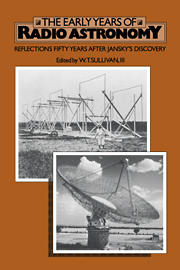Book contents
- Frontmatter
- Contents
- Preface
- THE EARLIEST YEARS
- AUSTRALIA
- ENGLAND
- THE REST OF THE WORLD
- BROADER REFLECTIONS
- Styles of research in three radio astronomy groups
- The influence of radio astronomy on cosmology
- Nanohertz astronomy
- Radio astronomy and the nature of science
- Biographical notes on contributors
- Name index
- Subject index
Radio astronomy and the nature of science
Published online by Cambridge University Press: 05 March 2010
- Frontmatter
- Contents
- Preface
- THE EARLIEST YEARS
- AUSTRALIA
- ENGLAND
- THE REST OF THE WORLD
- BROADER REFLECTIONS
- Styles of research in three radio astronomy groups
- The influence of radio astronomy on cosmology
- Nanohertz astronomy
- Radio astronomy and the nature of science
- Biographical notes on contributors
- Name index
- Subject index
Summary
The decade of the 1970s saw the four-hundredth anniversary of Kepler, the quinquecentennial of Copernicus, the tercentenary of the Greenwich Observatory, and the Einstein centennial. Now, at the beginning of the 1980s, we are celebrating the fiftieth anniversary of the beginnings of Karl Jansky's work in what was to become known as radio astronomy. The difference between those earlier anniversaries and the present one is that most of us have been, if not active participants, at least interested bystanders as the discoveries at radio wavelengths have made their impact upon astronomy. What we lack in historical perspective is perhaps compensated by the immediacy of our own experiences.
RECOLLECTIONS OF EARLY RADIO ASTRONOMY
J.S. Hey, in his 1973 book The Evolution of Radio Astronomy, has singled out the years 1950–51, as particularly crucial. In 1949 the Australian group of J.G. Bolton, G.J. Stanley, and O.B. Slee had given the first three optical identifications for discrete radio sources: Taurus A, the Crab Nebula; Virgo A, the elliptical galaxy M87; and Centaurus A, the peculiarly distorted galaxy NGC 5128. In 1950 H. Alfven and N. Herlofson introduced the idea that the observed radio emission from the discrete radio sources was synchrontron radiation, K.O. Kiepenheuer interpreted the radio emission of the Milky Way as synchrotron radiation from cosmic ray electrons spiraling in the interstellar magnetic field, and M. Ryle, F.G. Smith, and B. Elsmore published their preliminary list of fifty so-called radio stars in the northern hemisphere.
- Type
- Chapter
- Information
- The Early Years of Radio AstronomyReflections Fifty Years after Jansky's Discovery, pp. 399 - 408Publisher: Cambridge University PressPrint publication year: 1984
- 1
- Cited by

